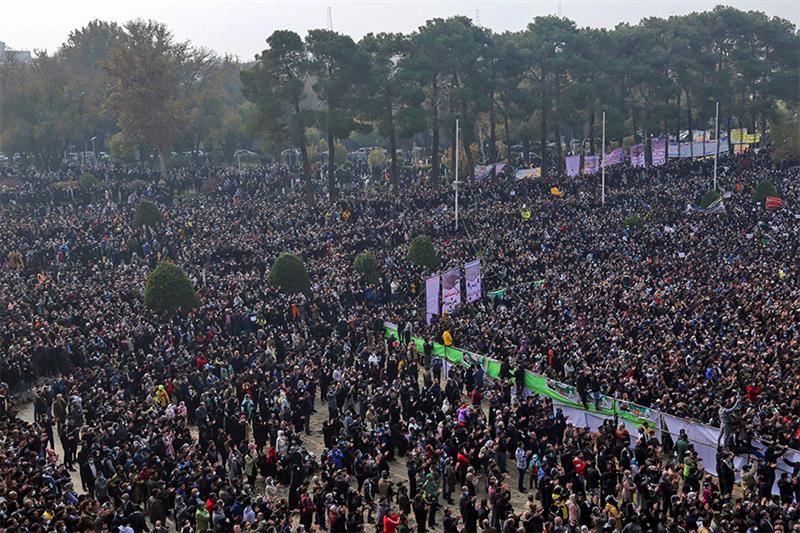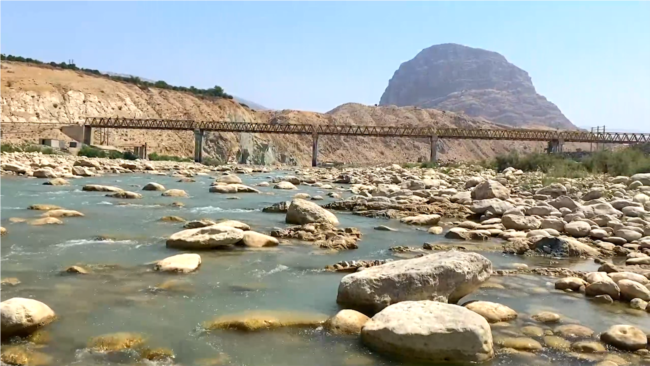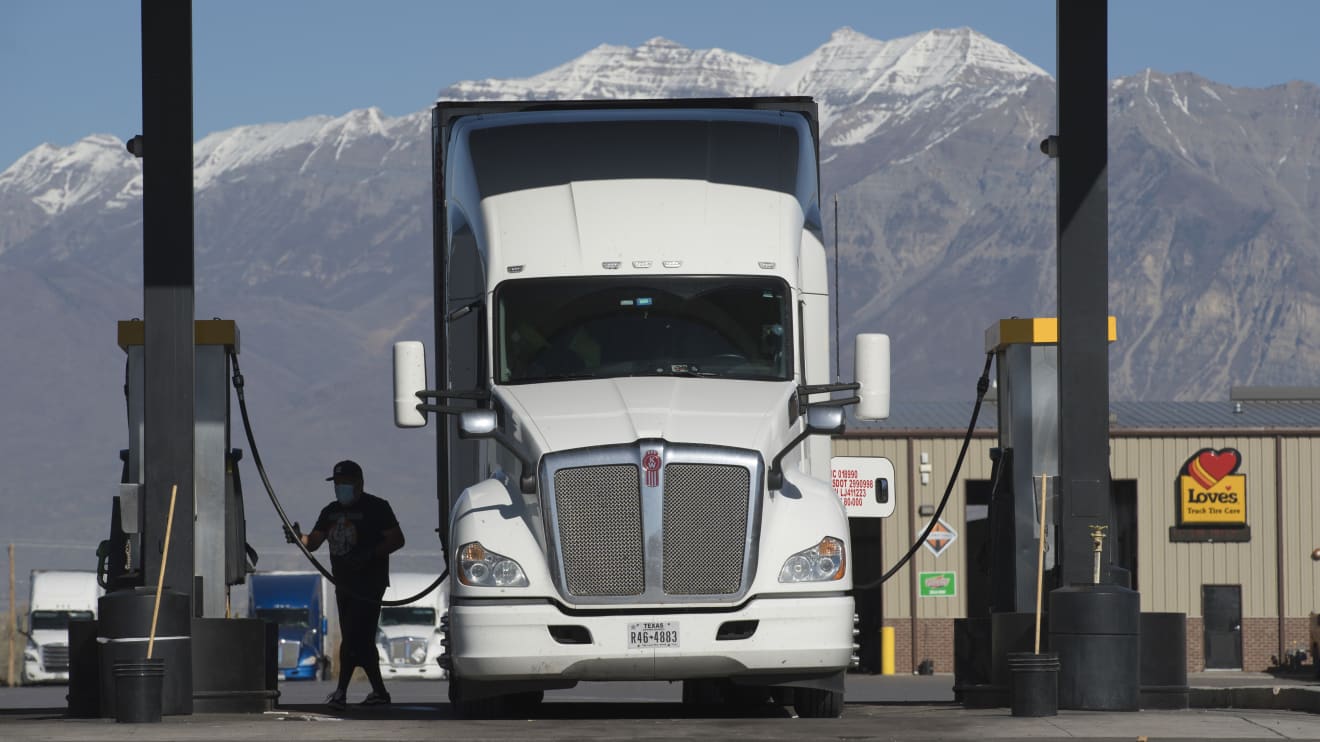NEWS WIRES 1 hour ago
Thousands of protesters converged on Isfahan in central Iran on Friday to voice their anger after the city's lifeblood river dried up due to drought and diversion.

The massive protest, that drew in farmers and other people from across Isfahan province, was the biggest since demonstrations over the water crisis started on November 9.
"Thousands of people from Isfahan, farmers from the east and west of the province, have gathered in the dry Zayandeh Rood riverbed with one key demand: let the river run," a state television journalist in Isfahan reported, broadcasting live images of Friday's rally.
"For years, there has been no will to resolve the problems of this important river," the journalist said.
Footage aired on the channel showed men and women in a crowd spanning the riverbed clapping in unison.
"Plundered for 20 years" and "the water must return", they chanted.
Others were seen holding up banners that read "East Isfahan has become desert" and "Our water is being held hostage", in pictures published by Iranian media outlets.
The city of Isfahan is Iran's third largest, with a population of around two million.
It is a tourist magnet due to its heritage sites, including a historic bridge that crosses the Zayandeh Rood river -- which has been dry since the year 2000 apart from brief periods.
Drought is seen as one of the causes, but farmers also blame the authorities' diversion of the river water to neighbouring Yazd province.
The Iranian government has promised to come to the aid of farmers and resolve the crisis.
"I have ordered the ministers of energy and agriculture to take immediate steps to deal with the issue," Iran's First Vice President Mohammad Mokhber said on television.
Energy Minister Ali-Akbar Mehrabian apologised to farmers for being unable to provide water for their crops.
"We hope to fill these gaps in the coming months," he said.
Iran's President Ebrahim Raisi had already met with representatives from the provinces of Isfahan, Yazd and Semnan on November 11 and promised to resolve water issues.
Largely arid Iran has been suffering chronic dry spells for years.
In July, deadly protests broke out in the southwestern province of Khuzestan after drought led to widespread water shortages.
Iran is one of the most water-stressed countries in the world.
Water levels in the country's lakes and reservoirs have halved since last year due to the severe drought affecting the country and the wider region, a report from Iran's space agency said in October.
(AFP)
Thousands protest dried-up river in Iran's Isfahan: State TV
AFP , Friday 19 Nov 2021
Thousands of protesters converged on Isfahan in central Iran on Friday to voice their anger after the city's lifeblood river dried up due to drought and diversion, state television said.

Related
"Thousands of people from Isfahan, farmers from the east and west of the province, have gathered in the dry Zayandeh Rood riverbed with one key demand: let the river run," a state television journalist in Isfahan reported, broadcasting live images of Friday's rally.
"For years, there has been no will to resolve the problems of this important river," the journalist said.
The city of Isfahan is Iran's third largest, with a population of around two million.
It is tourist magnet due to its heritage sites, including a historic bridge that crosses the Zayandeh Rood river -- which has been dry since the year 2000 apart from brief periods.
Drought is seen as one of the causes but farmers also blame the authorities' diversion of the river water to neighbouring Yazd province.
Iran's President Ebrahim Raisi met with representatives from the provinces of Isfahan, Yazd and Semnan on November 11 and promised to resolve water issues.
Largely arid Iran has been suffering chronic dry spells for years.
In July, deadly protests broke out in the southwestern province of Khuzestan after drought led to widespread water shortages.
Iranians Hold Mass Protest Over Poor Water Management Amid Drought
Thousands of people have joined a rally in central Iranian city of Isfahan to protest against water cuts and the drying up of the river that passes through Iran's third-largest city.
Images broadcast on state television on November 19 and videos published on social networks showed farmers and others from across Isfahan Province gathered in the dried-up river bed and elsewhere in the city, chanting slogans such as "Give Zayandeh Rood River back."
First Vice President Mohammad Mokhber said that meetings were being held over the issue to try to solve the water problem in Isfahan and elsewhere.
The protest movement started in Isfahan on November 8 and a number of demonstrators set up tents in the river bed last week.
Similar protests have been held across Iran in recent years.
In July, deadly rallies broke out in the southwestern province of Khuzestan amid widespread water shortages.

Failing Infrastructure, Low Rainfall Leave One Iranian Province Fighting For Water
The Iran Meteorological Organization has estimated that 97 percent of the country is experiencing drought to some degree.
Mismanagement by the authorities has also been cited as a main cause for the water crisis.


In this photo released by the semi-official Fars News Agency, farmers attend a protest demanding authorities open a dam to relieve drought-stricken areas of central province of Isfahan, on the dried up riverbed of the Zayandeh Roud river in the city of Isfahan 255 miles (410 kilometers) south of the capital Tehran, Iran, Friday, Nov. 19, 2021. Several prominent actors and athletes joined the peaceful movement, urging the government to intervene to aid famers increasingly suffering from droughts that have worsened over the years. (Hamidreza Nikoomaram/Fars News Agency via AP)
Fri, November 19, 2021, 4
TEHRAN, Iran (AP) — Thousands of farmers in central Iran joined a protest on Friday demanding authorities open a dam to relieve drought-stricken areas, state TV reported.
Several prominent actors and athletes have taken part in the peaceful demonstrations in the city of Isfahan, urging the government to intervene to aid famers increasingly suffering from droughts that have worsened over the years. The demonstrations began earlier this month.
Crowds marched alongside the banks of the city's once-famed but now dry Zayanderud River, chanting “Farmers! Farmers! We support you!" and "Give Esfahan a chance to breathe!”



The country's top vice-president, Mohamad Mokhber, later gave a brief statement to state TV, saying that meetings were being held over the issue and “we are seriously trying to solve the water problem ... especially for Isfahan.”
Drought has been a problem for Iran for some 30 years, but it has worsened over the past decade, according to the U.N.’s Food and Agriculture Organization. The Iran Meteorological Organization says that an estimated 97% of the country now faces some level of drought.
The farming area around Isfahan was once well supplied by the Zayanderud, but nearby factories have increasingly drawn on it over the years. The river once flowed under historic bridges in Isfahan's city center, but is now a barren strip of dirt.
In 2012, farmers clashed with police in a town in Isfahan province, breaking a water pipe that diverted some 50 million cubic meters of water a year to a neighboring province. Similar protests have continued sporadically since then, and the government at one point paid around $250 to each family hit by the crisis.
















